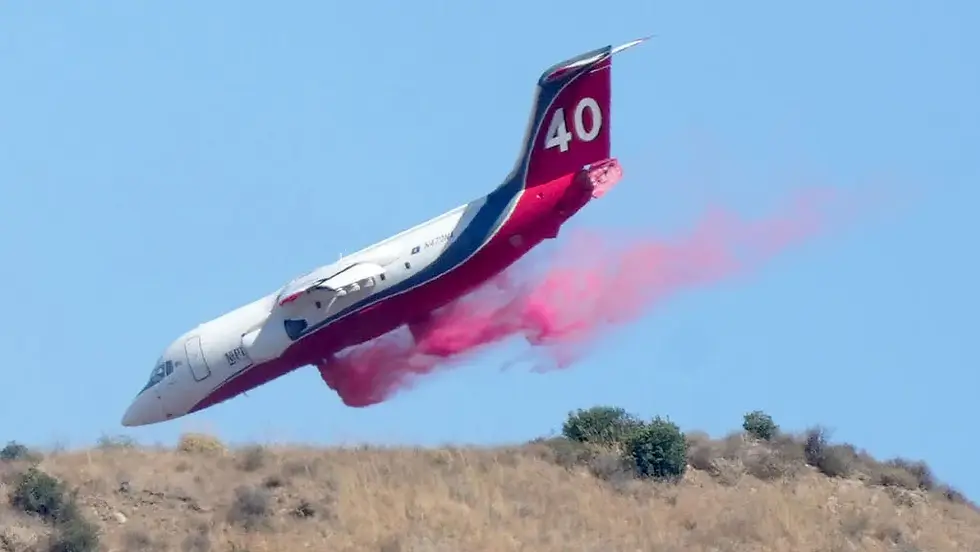Wildfire north of Los Angeles forces thousands to flee; containment grows
- Ani

- Aug 8
- 3 min read

Firefighters north of Los Angeles on Friday, Aug. 8, made progress in their battle against a wildfire that ignited a day earlier and exploded in size, forcing thousands of people to flee their homes.
The Canyon Fire was first reported around 1:30 p.m. on Aug. 7 in a mountainous area near Lake Piru, a resevior located about 50 miles northwest of downtown Los Angeles. The blaze soon threatened ranches and other nearby properties.
Fueled by dry conditions, high heat and strong winds, the fire has since grown to 4,856 acres of land in Ventura and Los Angeles counties, according to Cal Fire, the state's firefighting agency. The Los Angeles County Fire Departmentsaid containment grew to 25% and no structures have been reported damaged.
At least 400 firefighters as well as multiple helicopters and fixed-wing aircraft are involved in the response effort. Officials also requested additional firefighters, including hand crews, engines and bulldozers, Andrew Dowd, a spokesman for the Ventura County Fire Department, told the Ventura County Star, part of the USA TODAY Network.
"Firefighters are working incredibly hard through steep terrain in hot weather with very dry fuels," Dowd said.
The Canyon Fire was one of several blazes burning across California and the western U.S. as a heat wave grips a vast portion of the country. Among the large wildfires buring in the West was the Gifford Fire northwest of Los Angeles County – the largest wildfire the state has seen this year.
Canyon Fire map
Wildfires burn across the West amid widespread heat wave
The Canyon Firewasn't the only dangerous blaze that's recently led to evacuations in California and others states in the West.
The Gifford Fire burning in Santa Barbara and San Luis Obispo counties has consumed 155 square miles of land, making it the largest wildfire the state has seen this year. The blaze, which was 15% contained as of Aug. 8, is threatening hundreds of structures and has injured at least three people, officials said.
Get the Daily Briefingnewsletter in your inbox.
The day's top stories, from sports to movies to politics to world events.
Delivery: Daily
Your Email
In Riverside County, south of Palm Springs, the Rose Fire has burned 1,690 acres of land and was at 30% containment, according to Cal Fire. The blaze forced evacuation orders and is threatening nearly 500 structures, authorities said.
In Colorado, firefighters were battling blazes across the state that ignited amid a heat wave. One of the fires, the Lee Fire, was estimated to have burned 45,000 acres, making it the largest wildfire the state has seen this year.
California's historic year of wildfires
Well before the start of wildfire season, which runs from the summer through October, California experienced a number of devastating blazes that swept through the southern region of the state.
The Palisades and Eaton fires ignited in early January and exploded in size, fueled by record winds and drought conditions. The blazes tore across working class communities and ritzy cliffside mansions, torching thousands of homes. Officials have tied 31 deaths to the blazes, but a recent study suggested the fires may have led to as many as 440 deaths. With an estimated $65 billion in losses, the two wildfires are expected to be the costliest in recorded U.S. history.
The summer has kept up the uptick of wildfire activity. On Aug. 1, the Gifford Fire broke out northwest of Los Angeles County and has since torched 155 square miles of land, making it nearly three times the size of the Palisades and Eaton fire combined. Looking ahead, fire officials say heat waves and drought conditions will only fuel more blazes.
"Fire potential across California is expected to increase steadily through summer," Cal Fire said in a fire season outlook. "In Southern California, the threat is driven by persistent drought, high grass loads, and weakening coastal moisture. In Northern California, a developing flash drought and early-season dryness are pushing conditions toward critical levels faster than usual."




























































Comments